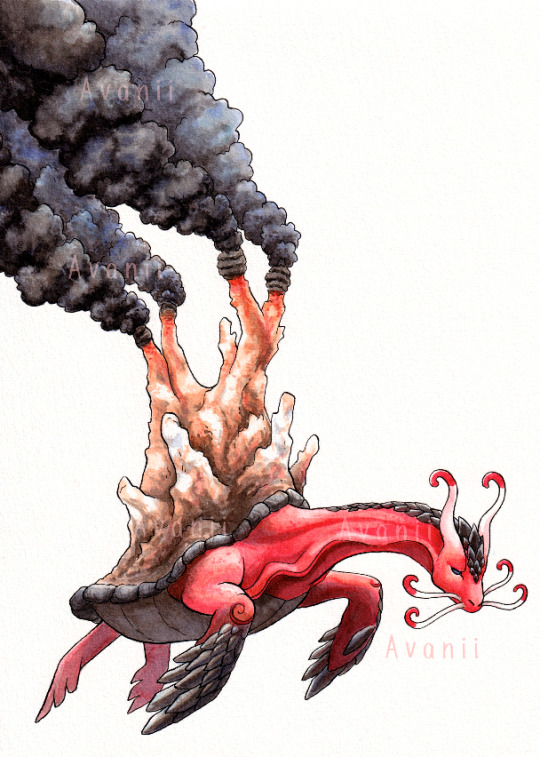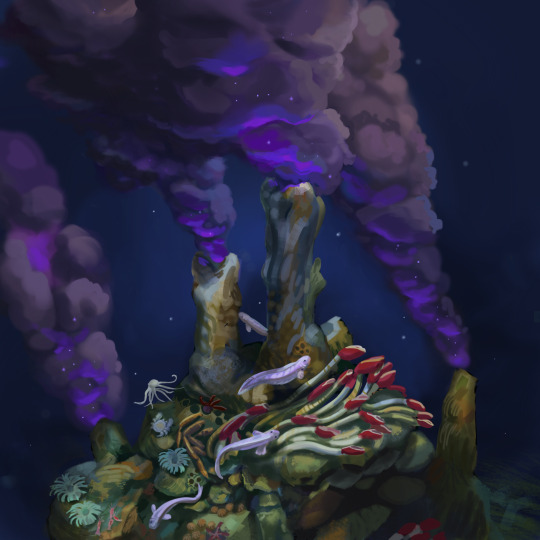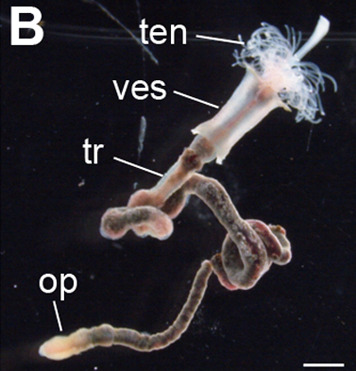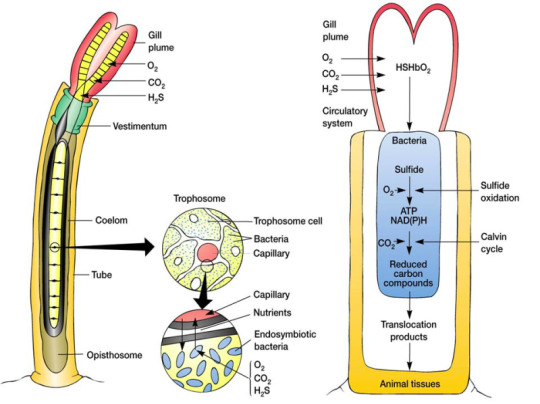#hydrothermal vent
Text

The Black Smoker Beast can be found roaming the spreading ridges in the depths of the oceans. Hydrothermal vents support a lot of life, so I wanted this creature to look a bit more friendly than my other geology monsters! The enormous, chimney-like structures are absolutely awe-inspiring and I hope I did them justice. I really wanted the beast to have such a chimney for a shell, and gave it the iron armour and red skin of the volcano snail, and white/red whiskers based on the tube worms that make their home at black smokers. Lots of fun again painting with acrylic inks.
#geology monster#volcano monster#black smoker#hydrothermal vent#deep sea creature#I'm really proud of this one#It went through a few different designs for the concept before I landed on this one#if you have never seen videos or photos of hydrothermal vents I beg you to look them up right now#the sheer size and scale of these things is just amazing#they look like underwater cathedrals in some cases#and I love how there's so much life on them too#avanii's art#traditional art
19 notes
·
View notes
Text

The Matterhorn, a hydrothermal vent in the Pescadero basin, supports red tube worms and white microbial mats.
(Image credit: Schmidt Ocean Institute)
#schmidt ocean institute#photographer#matterhorn#hydrothermal vent#pescadero basin#red tube worms#white microbial mats#marine#nature
11 notes
·
View notes
Text
(Please no vanilla extract or micro plastics this time—pollution is no laughing matter)
#poll#marine life#marine biology#deep sea#hydrothermal vent#extremophiles#fish#cephalopods#worms#molluscs#crabs#bacteria
50 notes
·
View notes
Text

Hydrothermal chimneys, salt pillars and terraces of Dallol. (Wikipedia)
#archive#archiving#web archive#dallol#dallol volcano#ethiopia#volcano#salt pillars#geology#hydrothermal vent#hydrothermal springs
47 notes
·
View notes
Photo

#tea#tea bag#making tea#dart#sera sophia#hydrothermal vent#deep sea#sometimes I really wish I were drawing on bristol board so I could in solid areas with a brush.. alas the printer paper is the affordable
16 notes
·
View notes
Text

source
2 notes
·
View notes
Text

Benthic Santas weren't even discovered until the 1970s, but many scientists now believe Christmas may have originally developed around hydrothermal vents and only later migrated to the surface.
Hydrothermal Vents [Explained]
Transcript Under the Cut
[Top label:] Smoke
[Middle label:] Chimneys
[Bottom label:] Santas being digested
[Caption below the panel:] Ocean fact: Hydrothermal vent black smokers actually evolved as predatory chimney mimics to feed on benthic Santas.
#xkcd#xkcd 2872#webcomics#hydrothermal vents#christmas#oceanography#marine biology#benthos#happy chrimbo.
4K notes
·
View notes
Text


Realized if I don't share my unfinished art, I won't share any at all. So here's an older character of mine, MEG. I was really having fun with this piece, but it got sooo huge. Gonna just start sharing stuff regardless.
She's on Artfight: here, and even has some badass art done by @ffirbolg from Artfight 2020.
#cherryzart#undead#ocean#hydrothermal vent#hell#demon#incarnation of death#skeleton#guess what I was into at the time of making this#shrimp heaven now#MEG#artfight
0 notes
Text
🪨🐟🪨 🪸🦈🪨🦀🦀⛰️🦀🦀🦀⛰️🦀🦀🦀⛰️🦀🦀🐙🐙
have a mid-atlantic ridge for your dash :)
#the mountains are meant to be hydrothermal vents :)#the coral is a deep sea one#the crabs are yeti crabs#etc#eddie in the ocean#marine biology
165 notes
·
View notes
Text

Hydrothermal vent party!!
130 notes
·
View notes
Text
Wet Beast Wednesday: giant tube worms
You voted that I would talk about a worm and so I shall discuss the mighty giant tube worms. But first, we need to define what a tube worm is. This is another "no such thing as a fish" situation because there are actually a lot of different things we call tube worms. Turns out the "noodle in a tube" body plan is a pretty successful one. The worms I'm discussing today are members of Siboglinidae, a family of annelids (segmented worms) that was formerly classified as two different phyla until genetic evidence came in. I will primarily be talking about two species: Riftia pachyptila and Lamellibrachia luymesi, who have both adapted to distinct extreme environments in similar ways.

(Image ID: multiple patches of Riftia pachyptila growing from rock at a deep-sea hydrothermal vent. The worms are housed in long, white tubes, some stained yellow. Emerging from the tubes are respiratory organs covered in what appears to be red fur. End ID)
All members of Siboglinidae share a basic body plan consisting of a worm body inside of a mineral tube (side not, I think I will be including an orc or ogre named Sibog in my D&D campaign). The tube is composed of chitin and minerals and is secreted through glands along the body of the worm as it grows from larva to adult. The tube provides the worm within with protection from predators and environmental hazards while also providing support, allowing the worm to lift itself up into the water rather than remain on the substrate. The tube either connects to a solid object or is rooted in the sediment with extensions called roots. The roots are composed of the same material as the tube and can be considerably longer than the rest of the worm, though they are so fragile it is hard to study them. Since the worms often live in large congregations, their roots can twist together is massive mats called ropes. The inside of the tube is where you get into the squishy worm parts. The body of the worm is divided into four regions. The first of these regions I found many alternate names for while researching including cephalic lobe and branchial plume. I'm going to simplify and call it the plume because this segment is composed of one to 200 tentacles that are covered with feathery filaments that can make it look like the plume of a quill pen. The feathery portions of the plume are usually red because they are highly vascularized and filled with blood, similar to a fish's gils. The plume is used for respiration, taking in dissolved oxygen and (depending on the species) other dissolved gasses from the water. In most species, the plume is the only part of the body that extends from the tube. When in the presence of threats, the plume can withdraw into the tube, which can then be close with a structure called the obtraculum, similarly to the operculum found in many other invertebrates like snails. The second body region is the vestimentum. It has a winged shape and is composed of multiple bands of muscle. The vestimentum also contains the heart, a simple brain, and genital pores that release gametes. The third body region, which makes up most of the body, is the trunk. The trunk is the wormiest part of the worm and contains the gonads, the coelom (main body cavity), and the trophosome, which I will come back to later. The last body region is the opistosome, which connects the animal to the tube and is used to store and (maybe) excrete waste.

(Image ID: the tubeworm Lamellicrachia satsuma removed from its tube to show its anatomy. It has a plume made up of multiple feathery white tentacles, the vestimentum is a thick white section with flared tips, the trunk is long, brown, and wormlike, and ends with the yellowish opistosome. The body regions are labeled as "op" for opistosome, "tr" for trunk, "ves" for vestimentum, and "ten" for the plume. End ID. Source)
You'll notice that I didn't mention a digestive tract above. That's because these worms don't have one. Instead of a digestive tract, they have a trophosome, an organ composed of highly spongy tissue vascularized by two main blood vessels. Housed within the trophosome is a colony of bacteria that exists in a mutualistic symbiotic relationship with the worm. The worm provides the bacteria with a place to live and protection from predators while the bacteria provide the worm with all of its nutrition. The bacteria are all chemoautotrophs, gaining all their nutrition from chemical reactions using chemicals in their environment without needing to intake nutrients. In particular, they use oxygen, carbon dioxide, and hydrogen sulfide provided to them by the worm. The worm also provides other elements including nitrogen and phosphorus that the bacteria need. I'm going to be honest with you, I tried to comprehend the chemical reactions involved but it's been a long time since I took chemistry and I was never that good anyway so it's over my head. The short version is that the bacteria produces nutrients and chemicals (primarily carbohydrates and ATP) that it shares with the worm. Waste products are also sent into the worm's bloodstream and are sequestered at the opistosome.

(Image ID: a scientific diagram of the internal anatomy of Riftia pachyptila. Of note is the section showing the trophosome, illustrating it as several yellow, spongy cells filled with bacteria and fed by a capillary. End ID. Source)
The most famous of the tube worms is Riftia pachyptila, which you will recognize if you have ever seen a documentary about the deep sea. They're the ones that look like giant tubes of lipstick. These are the most studied of the Siboglinids and live around hydrothermal vents in the deep pacific ocean. Hydrothermal vents are places on the seafloor where water underground is heated by geothermal activity in the Earth's mantle and then released into the water column, often carrying with it chemicals from deeper in the planet. These vents are hotspots of biodiversity in the deep sea and are hypothesized to play a major role in the origin of life. These ecosystems are among the only ones on the planet where the primary source of energy is not sunlight via photosynthesizing organisms. Instead, chemosynthetic bacteria forms the base of the trophic web, generating energy from the heat and chemicals released by the vents. Riftia requires vents which release sulfur into the water and blanket vents with the right conditions all throughout the Pacific. The lifestyle clearly works for them as they have the fastest grown rate of any marine animal. They can go from a larva to a sexually mature adult of 1.5 meters (4.9 ft) long in 2 years. These worms can reach 3 meters in length (9.75 ft) long, but only get to about 4 cm (1.5 in) in diameter within the tube. When reproducing, males will release blobs of stuck-together sperm called spermatozeugmata that collectively swim towards female worms, entering the tube and seeking out the female's oviduct. The female then releases fertilized larvae into the water. These larvae usually spend a few days in the water column before settling down on the substrate and beginning growth into an adult. However, the larvae have been known to reach newly-formed hot vents up to 200 kilometers away from their parent's vents. We don't know how the larvae find new sites to colonize or how long they can remain in the initial, motile state before succumbing to starvation as the larvae do not have digestive tracts and do not develop their internal bacterial colony until they settle down on the substrate. Once the larva does settle down, it develops its internal colony by intaking bacteria from the water using the plume. Riftia are some of the first organisms to colonize a new vent and play a major role in building that vent's ecosystem. Genetic tests show low genetic diversity amongst and between all colonies, which may be a result of how fast they colonize new vents and the fact that if a vent goes dormant or dies, all of the local worms will die with it.

(Image ID: a cluster of Rifita tubeworms, most of whom have their red, feathery plumes exposed. Some tubes do not have exposed plumes, indicating that either the worm has retracted into the tube or the worm has died. Several crabs are crawling on the tubes. End ID)
The other giant tube worm species I'm spotlighting is Lamellibrachia luymesi. These aren't as flamboyant as Riftia, but can get nearly as large (up to 3 meters) and also play a very important role in their ecosystems, though they are less studied. While Riftia likes it hot, Lamellibrachia is more chill. They live at cold seeps, places in the ocean where hydrogen sulfide and hydrocarbons like methane and oil seep out of the sea floor. Like Riftia, these worms depend entirely on an internal bacterial colony for their nutrition. Oxygen is intaken through the plume, but these worms can't get hydrogen sulfide the same way due to the different conditions. Instead, they absorb the sulfide through their roots. While the hot and cold worms absorb their hydrogen sulfide differently, they both have an adaptation to deal with it: specialized hemoglobin. Most forms of hemoglobin can't carry oxygen in the presence of hydrogen sulfide, which is a problem because that's the whole point of hemoglobin. The tube worms, who need to transport hydrogen sulfide, have specialized hemoglobin that seems to use zinc ions to allow for oxygen to bind to it anyway. The cold seep tube worms also excrete their waste products through the roots, returning it to the sediment. The intake of hydrogen sulfide and sequestering of the wast product in the roots and sediment lets the tube worms play an important role in the cold seep ecosystem. Them intaking the sulfide protects organisms who can't handle it as well and sequestering waste products also keeps it away from organisms who could be harmed by the chemicals in it. Hot vents are inherently unstable places. They are formed primarily in places where two tectonic plates are moving away from each other, exposing the planet's mantle. This exposed spot will eventually cool down and the hot vent will die off. Because of this, hot vent ecosystems grow fast and die young. Cold seeps by contrast are extremely stable and long-lasting. Lamellibrachia luymesi grow very slowly and can live for over 250 years. There's no need to hurry when your food comes out of the ground and won't be going anywhere for a very, very long time.

(Image ID: a colony of Lamellibrachia luymesi. Their tubes are more visibly segmented than those of Rifita, with the top of each segment being noticably wider than the base of the next. The tubes are a pale blue, but switch to white at 2 - 9 segments below the top. Many tubes have brown algae growing on them. The exposed plumes are short, red, and feathery. End ID)
#wet beast wednesday#tube worms#giant tube worms#Lamellibrachia luymesi#Riftia pachyptila#worm#wormblr#hydrothermal vents#cold seeps#marine biology#marine life#annelids#chemosynthesis#zoology#ecology#biology#long post#image described
106 notes
·
View notes
Text
i love my friends and i also love. hydrothermal vents, whales
59 notes
·
View notes
Text

Hydrothermal vent teeming with life.
Source: amnh.org
#archive#archiving#web archive#ocean#sea#deep ocean#deep sea#hydrothermal vent#fish#sea life#aquatic#aquatic creatures#aquatic life
5 notes
·
View notes
Text

had to design a classical CD cover for art class. i turned it into an opportunity to expeirment with making art using the lasso selection tool, i like the lava a lot!
#digital art#firealpaca#deep sea#marine biology#greenland sharks#hydrothermal vents#volcano#artists on tumblr
176 notes
·
View notes
Text
Going on dates is fun. I never know when is the right time to break it to the person I’m dating my interests are largely restricted to personal characterizations of 7 stupid elves that live in my brain and will likely continue to do so for several more years, if not longer.
#I never want to outright say: yeah I’m autistic but I am fairly certain people can tell#I usually try to start with other interests or ask them about theirs#but that’s also hard when your interests are hydrothermal vents or tornados. like what do you say to that?#anygays I’m in a first council obsession period again. I’m working on drawing my headcanons for all of them
33 notes
·
View notes
